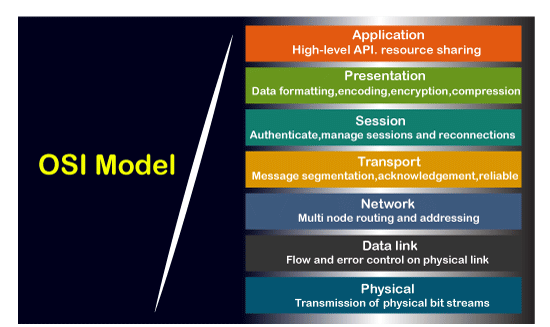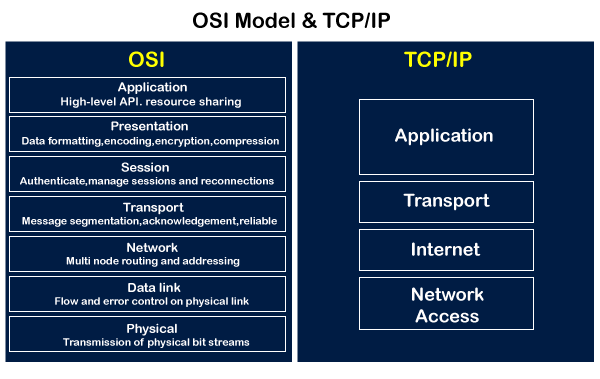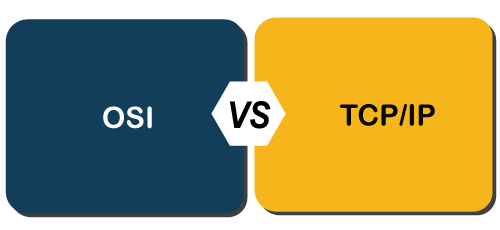Tutorial
Physical Layer
Data Link layer
Network Layer
Routing Algorithm
Transport Layer
Application Layer
Network Security
Misc
- Router
- OSI vs TCP/IP
- TCP vs UDP
- Transmission Control Protocol
- TCP port
- IPv4 vs IPv6
- ARP Packet Format
- ARP Table
- Working of ARP
- FTP Client
- FTP Commands
- FTP Server
- I2C Protocol
- Sliding Window Protocol
- SPI Protocol
- IP
- ARP Commands
- ARP
- Address Resolution Protocol
- ARP and its types
- TCP Retransmission
- CAN protocol
- HTTP Status Codes
- HTTP vs HTTPS
- RIP Protocol
- UDP Protocol
- ICMP Protocol
- MQTT protocol
- OSPF Protocol
- Stop and Wait Protocol
- IMAP Protocol
- POP Protocol
- CIFS
- DAS
- DIMM
- iSCSI
- NAS (Network Attached Storage)
- NFS
- NVMe
- SAN
- Border Gateway Protocol
- Go-Back-N ARQ
- RJ Cable
- Difference between Connection-Oriented and Connectionless Service
- CDMA vs. GSM
- What is MAC Address
- Modem vs. Router
- Switch Vs. Router
- USB 2.0 vs 3.0
- Difference between CSMA CA and CSMA CD
- Multiple access protocol- ALOHA, CSMA, CSMA/CA and CSMA/CD
- URI vs URL
- IMAP vs. POP3
- SSH Meaning| SSH Protocol
- UTP vs STP
- Status Code 400
- MIME Protocol
- IP address
- proxy server
- How to set up and use a proxy server
- network security
- WWW is based on which model
- Proxy Server List
- Fundamentals of Computer Networking
- IP Address Format and Table
- Bus topology and Ring topology
- Bus topology and Star topology
- Circuit Switching and Packet switching?
- Difference between star and ring topology
- Difference between Router and Bridge
- TCP Connection Termination
- Image Steganography
- Network Neutrality
- Onion Routing
- Adaptive security appliance (ASA) features
- Relabel-to-front Algorithm
- Types of Server Virtualization in Computer Network
- Access Lists (ACL)
- What is a proxy server and how does it work
- Digital Subscriber Line (DSL)
- Operating system based Virtualization
- Context based Access Control (CBAC)
- Cristian's Algorithm
- Service Set Identifier (SSID)
- Voice over Internet Protocol (VoIP)
- Challenge Response Authentication Mechanism (CRAM)
- Extended Access List
- Li-fi vs. Wi-fi
- Reflexive Access List
- Synchronous Optical Network (SONET)
- Wifi protected access (WPA)
- Wifi Protected Setup (WPS)
- Standard Access List
- Time Access List
- What is 3D Internet
- 4G Mobile Communication Technology
- Types of Wireless Transmission Media
- Best Computer Networking Courses
- Data Representation
- Network Criteria
- Classful vs Classless addressing
- Difference between BOOTP and RARP in Computer Networking
- What is AGP (Accelerated Graphics Port)
- Advantages and Disadvantages of Satellite Communication
- External IP Address
- Asynchronous Transfer Mode (ATM)
- Types of Authentication Protocols
- What is a CISCO Packet Tracer
- BOOTP work
- Subnetting in Computer Networks
- Mesh Topology Advantages and Disadvantages
- Ring Topology Advantages and Disadvantages
- Star Topology Advantages and Disadvantages
- Tree Topology Advantages and Disadvantages
- Zigbee Technology-The smart home protocol
- Network Layer in OSI Model
- Physical Layer in OSI Model
- Data Link Layer in OSI Model
- Internet explorer shortcut keys
- Network Layer Security | SSL Protocols
- Presentation Layer in OSI Model
- Session Layer in OSI Model
- SUBNET MASK
- Transport Layer Security | Secure Socket Layer (SSL) and SSL Architecture
- Functions, Advantages and Disadvantages of Network Layer
- Protocols in Noiseless and Noisy Channel
- Advantages and Disadvantages of Mesh Topology
- Cloud Networking - Managing and Optimizing Cloud-Based Networks
- Collision Domain and Broadcast Domain
- Count to Infinity Problem in Distance Vector Routing
- Difference Between Go-Back-N and Selective Repeat Protocol
- Difference between Stop and Wait, GoBackN, and Selective Repeat
- Network Function Virtualization (NFV): transforming Network Architecture with Virtualized Functions
- Network-Layer Security | IPSec Modes
- Next - Prev Network-Layer Security | IPSec Protocols and Services
- Ping vs Traceroute
- Software Defined Networking (SDN): Benefits and Challenges of Network Virtualization
- Software Defined Networking (SDN) vs. Network Function Virtualization (NFV)
- Virtual Circuits vs Datagram Networks
- BlueSmack Attack in Wireless Networks
- Bluesnarfing Attack in Wireless Networks
- Direct Sequence Spread Spectrum
- Warchalking in Wireless Networks
- WEP (Wired Equivalent Privacy)
- Wireless security encryption
- Wireless Security in an Enterprise
- Quantum Networking
- Network Automation
- Difference between MSS and MTU
- What is MTU
- Mesh Networks: A decentralized and Self-Organizing Approach to Networking
- What is Autonomous System
- What is MSS
- Cyber security & Software security
- Information security & Network security.
- Security Engineer & Security Architect
- Protection Methods for Network Security
- Trusted Systems in Network Security
- What are Authentication Tokens in Network security
- Cookies in Network Security
- Intruders in Network Security
- Network Security Toolkit (NST) in virtual box
- Pivoting-Moving Inside a Network
- Security Environment in Computer Networks
- Voice Biometric technique in Network Security
- Advantages and Disadvantages of Conventional Testing
- Difference between Kerberos and LDAP
- Cyber security and Information Security
- GraphQL Attacks and Security
- Application Layer in OSI Model
- Applications of Remote Sensing
- Seven Layers of IT Security
- What is Ad Hoc TCP
- What is Server Name Indication(SNI)
OSI vs TCP/IP
What is OSI model?
The OSI stands for Open System Interconnection, which was developed in 1980s. It is a conceptual model used for network communication. It is not implemented entirely, but it is still referenced today. This OSI model consists of seven layers, and each layer is connected to each other. The data moves down the OSI model, and each layer adds additional information. The data moves down until it reaches the last layer of the OSI model. When the data is received at the last layer of the OSI model, then the data is transmitted over the network. Once the data is reached on the other side, then the process will get reversed.

What is TCP/IP model?
The TCP model stands for Transmission Control Protocol, whereas IP stands for Internet Protocol. A number of protocols that make the internet possibly comes under the TCP/IP model. Nowadays, we do not hear the name of the TCP/IP model much, we generally hear the name of the IPv4 or IPv6, but it is still valid. This model consists of 4 layers. Now, we will look at the diagrammatic representation of the TCP/IP model.

As shown in the above diagram, the TCP/IP model has 4 layers, while the OSI model consists of 7 layers. Diagrammatically, it looks that the 4 layers of the TCP/IP model exactly fit the 7 layers of the OSI model, but this is not reality. The application layer of the TCP/IP model maps to the first three layers, i.e., application, session, and presentation layer of the OSI model. The transport layer of the TCP maps directly to the transport layer of the OSI model. The internet layer of the TCP/IP model maps directly to the network layer of the OSI model. The last two layers of the OSI model map to the network layer of the TCP/IP model. TCP/IP is the most widely used model as compared to the OSI model for providing communication between computers over the internet.
Similarities between the OSI and TCP/IP model
The following are the similarities between the OSI and TCP/IP model:
- Share common architecture
Both the models are the logical models and having similar architectures as both the models are constructed with the layers.
- Define standards
Both the layers have defined standards, and they also provide the framework used for implementing the standards and devices.
- Simplified troubleshooting process
Both models have simplified the troubleshooting process by breaking the complex function into simpler components.
- Pre-defined standards
The standards and protocols which are already pre-defined; these models do not redefine them; they just reference or use them. For example, the Ethernet standards were already defined by the IEEE before the development of these models; instead of recreating them, models have used these pre-defined standards.
- Both have similar functionality of 'transport' and 'network' layers
The function which is performed between the 'presentation' and the 'network' layer is similar to the function performed at the transport layer.
Differences between the OSI and TCP/IP model

Let's see the differences between the OSI and TCP/IP model in a tabular form:
| OSI Model | TCP/IP Model |
|---|---|
| It stands for Open System Interconnection. | It stands for Transmission Control Protocol. |
| OSI model has been developed by ISO (International Standard Organization). | It was developed by ARPANET (Advanced Research Project Agency Network). |
| It is an independent standard and generic protocol used as a communication gateway between the network and the end user. | It consists of standard protocols that lead to the development of an internet. It is a communication protocol that provides the connection among the hosts. |
| In the OSI model, the transport layer provides a guarantee for the delivery of the packets. | The transport layer does not provide the surety for the delivery of packets. But still, we can say that it is a reliable model. |
| This model is based on a vertical approach. | This model is based on a horizontal approach. |
| In this model, the session and presentation layers are separated, i.e., both the layers are different. | In this model, the session and presentation layer are not different layers. Both layers are included in the application layer. |
| It is also known as a reference model through which various networks are built. For example, the TCP/IP model is built from the OSI model. It is also referred to as a guidance tool. | It is an implemented model of an OSI model. |
| In this model, the network layer provides both connection-oriented and connectionless service. | The network layer provides only connectionless service. |
| Protocols in the OSI model are hidden and can be easily replaced when the technology changes. | In this model, the protocol cannot be easily replaced. |
| It consists of 7 layers. | It consists of 4 layers. |
| OSI model defines the services, protocols, and interfaces as well as provides a proper distinction between them. It is protocol independent. | In the TCP/IP model, services, protocols, and interfaces are not properly separated. It is protocol dependent. |
| The usage of this model is very low. | This model is highly used. |
| It provides standardization to the devices like router, motherboard, switches, and other hardware devices. | It does not provide the standardization to the devices. It provides a connection between various computers. |


